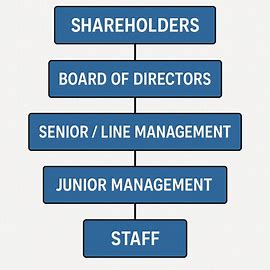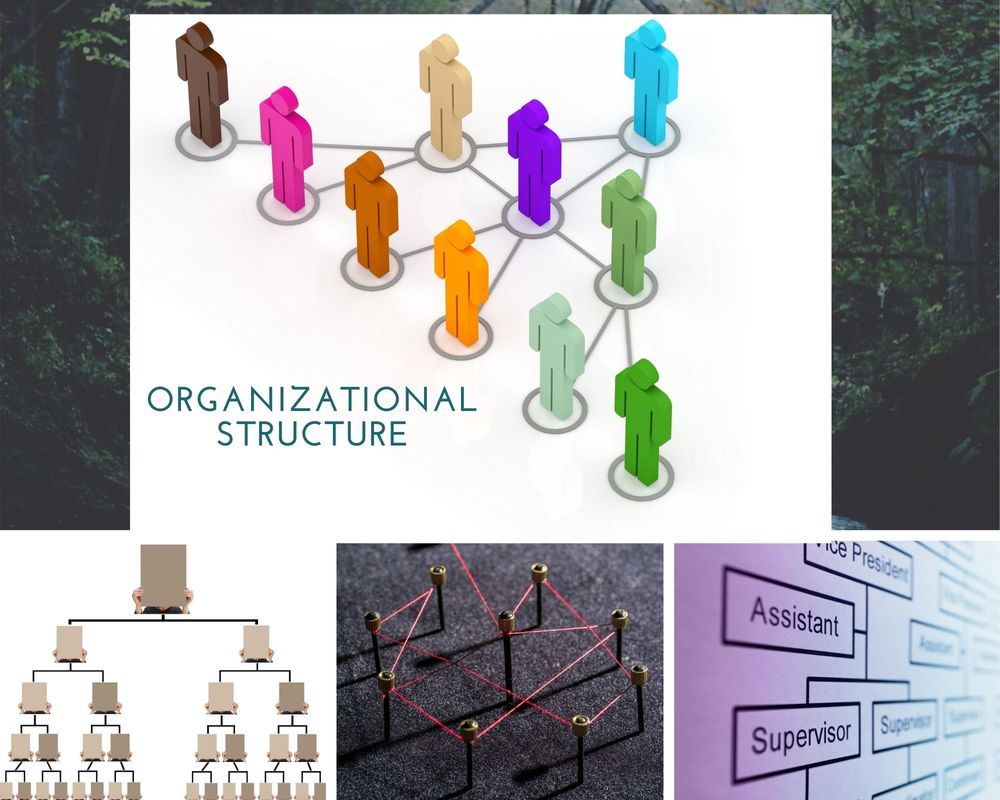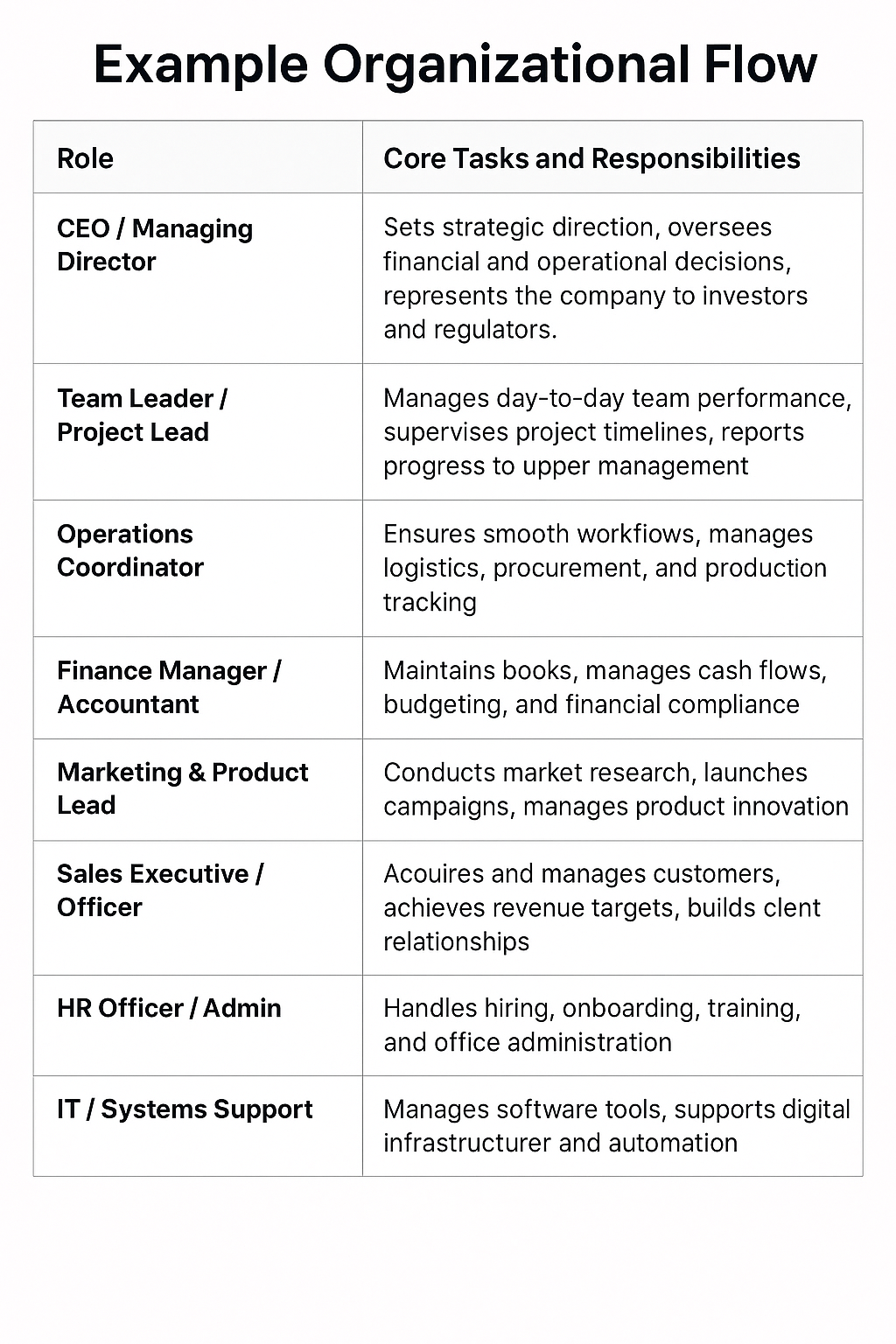Organizational Structure
Organizational Structure - Introduction
Building a solid organizational structure is essential to any enterprise’s success. It defines roles, decision‑making lines, and operational clarity. Whether you're launching a Private Limited Company, a consultancy, or a growing startup in Pakistan, this guide helps you plan your structure in clear steps.
Organizational Structure - A Step‑by‑Step Strategy for Efficient Teams
1. Understand the Corporate Tiers
Most organizations operate across three tiers:
- Shareholders: Investors or business owners.
- Board of Directors: Provide strategic oversight.
- Management / Officers: Handle day‑to‑day operations.
In small firms, these roles often overlap. The business owner may act as shareholder, director, and manager simultaneously.
 Organizational Structure-Base
Organizational Structure-Base2. Identify the Four Core Structure Types
You have four basic frameworks for organizing your team:
- Functional – Grouped by expertise (e.g. finance, operations, HR).
- Divisional – Separated by product lines or markets.
- Matrix – Combines functional and divisional reporting.
- Flat – Minimal hierarchy; staff take responsibility for own tasks
Mini‑scenario: A small fashion design studio opts for a flat structure, letting designers oversee their own clients while consulting an operations lead for logistics.
3. Draw an Organizational Chart (Organogram)
An effective chart visualizes reporting lines, authority levels, and responsibilities.
 Organizational Structure
Organizational StructureStart at the Management tier. Essential roles for a lean company:
- CEO
- Operations Coordinator
- Team Leader
- Finance Manager
- Marketing & Product Development Lead
- Sales Team
- Human Resources
- Administration Officer
- IT / Systems Personnel
Mini‑scenario: A tech consultancy hires an operations coordinator and outsources finance and IT initially, evolving roles over time.
4. Lay Out a Step‑by‑Step Implementation Road Map
Step A: Role Mapping
List all functions your business needs. For lean operations, combine roles (e.g. marketing + sales, finance + admin).
Step B: Advisory Support
Bring in experts on hourly consult basis before hiring full-time staff—in areas such as HR, finance or tech.
Step C: Develop Organogram
Transform your role list into a simple organogram with clear lines of reporting.
Step D: Staffing Rollout
Decide whether to engage team members as contractors or full-time based on workload and budget.
Step E: Review & Scale
As business grows, revisit the organogram. Add or separate roles—e.g. split finance from admin or hire dedicated HR—when justified by revenue or complexity.
5. Optimize for Growth & Efficiency
- Use systems and automation to streamline processes (especially for finance and operations).
- Monitor staff workload to avoid burnout and over‑staffing.
- Align structure with your business model and projected expansion plans.
6. Ensure Role Clarity and Authority
Every team member should know:
- Their job scope/description
- Who they report to
- Which decisions they can make autonomously
Tools like written job descriptions and SOPs keep authority transparent and reduce overlap.
Mini‑scenario: In a micro‑enterprise exporting handicrafts, the operations person handles shipping logistics and liaises with customs; finance keeps track of order payments; marketing adds product listings and organizes trade events.
7. Adapt According to Structure Type
- Functional: Specialists report to respective vertical heads (e.g. Finance → Finance Manager).
- Divisional: Each product line or region has its own mini‑team (e.g. marketing, sales, operations grouped per division).
- Matrix: A staff member may report to both a functional leader and a divisional head.
- Flat: Lines of supervision are minimal, ideal for creative or project‑based teams.
8. Basic Idea of Expertise for each role
Organizational Structures or Charts/Organograms give an idea on how you can build your team effectively. We need the following broad talents/qualifications to get any organization going.
Usually these are found in structured Corporate entities, however, can be replicated in some form and style for smaller companies as well.
Let's take a Limited Liability Company i.e Private Limited Company and see how we can make a similar arrangement without a incurring a huge salary bill.
1. Team Leader - Multi faceted with a holistic vision;
2. Operations Person - To competently co-ordinate the operational flows of the company;
3. Finance Person - For keeping the financial health of the company in check, making projections, estimates and then keeping a record of all inflows and outflows;
4. Marketing Person - Business development expert who can promote the company's products, brand and general traits to the target audience. Should be able to identify the correct market and have the tools to get the product into the market effectively. Should also be able to develop new features in existing products and float new ideas i.e. do product development.
Marketing personnel also need to maintain relationship with existing clients on a long term basis. Marketing campaigns and events to promote the company are also developed by the marketing person;
5. Sales Team - These are different from the marketing people as they actually close the deal. They are the field staff that take the product to the market and make the sale;
6. HR Person - To manage the human resources requirement of the company that includes developing job descriptions, hiring competent staff, maintaining the records of the staff and most important developing regular training programs for the staff;
7. Administration Person - To effectively manage administrative expenses that relate to day to day expense incurred for the smooth running of the company which include purchase/rent and maintenance of premises, equipment and machinery, furniture and fixture, vehicles, stationery, food and beverages, traveling expenses and such other expenses;
8. IT personnel - The 'Techies' to maintain the software programs that keep the process going smoothly. Systems and process with automation not only reduce time delays but also help the management in arriving at timely decisions to make the business successful. All software programs required to run a business smoothly need customization to integrate the requirements of each company into the system and have an effective tool at the company's disposal;
9. Junior Executives - Under each head given above there is a need for junior and mid level staff to assist the head of the department in delivering their duties in a timely manner;
10. Clerical Staff - This segment of the staff includes data entry personnel, typist, secretaries, office assistant, telephone operators, etc.; and
11. Non - Clerical Staff - These are usually the least technical people i.e. drivers, guards, peons, janitorial staff etc.
The organization chart for each company is made as per its staff requirement. As per the above company's staff, we can make the required Organization Chart also known as an "Organogram".
Remember, you need a team in one way or another to build a successful business. A lean company can be managed with the help of outsourcing several of the above functions to keep the salary bill under control while acquiring services of qualified and experienced personnel.
Final Scenario: Launching Your SME with Confidence
Imagine you're launching a handcrafted textiles export business in Karachi:
- You start by drawing a basic organogram with yourself (owner) leading.
- Initially, operations and admin tasks are managed by one person part-time.
- You hire a marketing‑cum‑sales consultant to generate clients.
- After securing buyers, you onboard a part‑time finance consultant and an IT freelancer to implement inventory and invoicing systems.
- As sales grow, you hire full-time HR/admin and finance roles, formalizing responsibilities.
- The structure evolves: you may split operations into production and logistics roles and engage separate marketing and product development staff.
Over time, your organization matures into a scalable, well‑ordered model with team clarity and efficiency.
Organizational Structure - Flow
 Organizational Structure - Flow
Organizational Structure - Flow- Home
- Business Plan
- Organizational Structure


